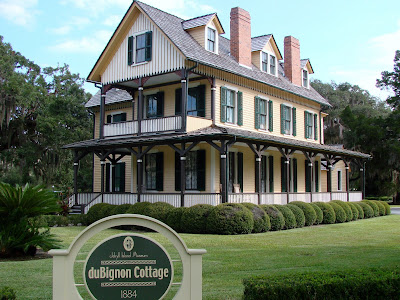Many members of the Jekyll Island Club brought their own horses and carriages along with the coachmen and stable boys from their northern homes. This was the Baker-Crane Carriage House. The employees were housed on the second floor.
This cottage was built in 1916 for boat engineer John Courier. The third family to live in the cottage was Christian Nielsen's. He was the carpenter for the club.
The du Bignon house was not large enough for the club so it was used for offices.
The property was bought from the du Bignon family.
Henry Hyde built San Souci with it's six apartments to gain some privacy from the Clubhouse. Also in the building were J. Pierpont Morgan, James A. Scrymser (American Telegraph), William Anderson (American Cotton Oil Co.), and Joseph Stickney.
Frank Goodyear built his cottage in 1906 but died a year later "worn out with ceaseless activity and worry." He began his career with $100 and left his heirs a $10,000,000 estate. By the early 20th century Jekyll Island Club members supposedly represented 1/6 of the world's wealth.
Most of the smaller cottages are used for shops now. The tram is a popular way to tour the historic district. We preferred to use bicycles that allowed us to stop and gawk.
Mrs. Bakeer did not rebuild but sold her lot to Richard Crane, Jr. who built the largest and most expensive cottage in the compound. There were numerous bathrooms as he was the president of the Crane Company which specialized in plumbing fixtures.
Throughout the historic district were tourists either riding bikes, carriages, trams, or walking. Cars are not permitted in the area. These women are discussing where to go as they leave the Jekyll Island Club Hotel.
The clubhouse was built in Queen Anne style for $45,000 for the 53 members, their families and guests. Notice the beautifully manicured croquet lawn in the front. We did not stay here but we sure sat on the veranda and enjoyed lunch or pastries a few times.
From 1886-1942 the members anchored their yachts at the club wharf. JP Morgan had the largest and was escorted ashore by a flotilla of smaller craft after a cannon had sounded off his arrival.
This bridge to the island was nonexistant until the 1950s so any visitors to the island had to come by water.
Bicycling was the perfect way to travel through the district. We stopped and read every sign.
Dr. George Shrady built this cottage in 1904. He was the attendant to ex-President Grant. In 1925 Dr. Walter James, a retired lecturer at Columbia University, bought the cottage and named it Cherokee.
I am not sure why each butterfly I capture has tattered wings. Imagine the marigolds still in bloom in late October.





















No comments:
Post a Comment